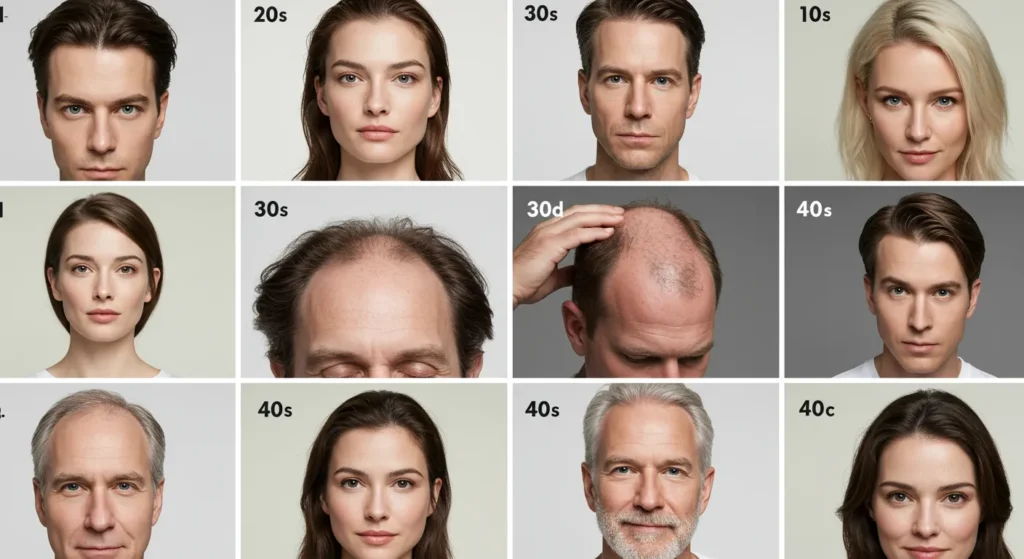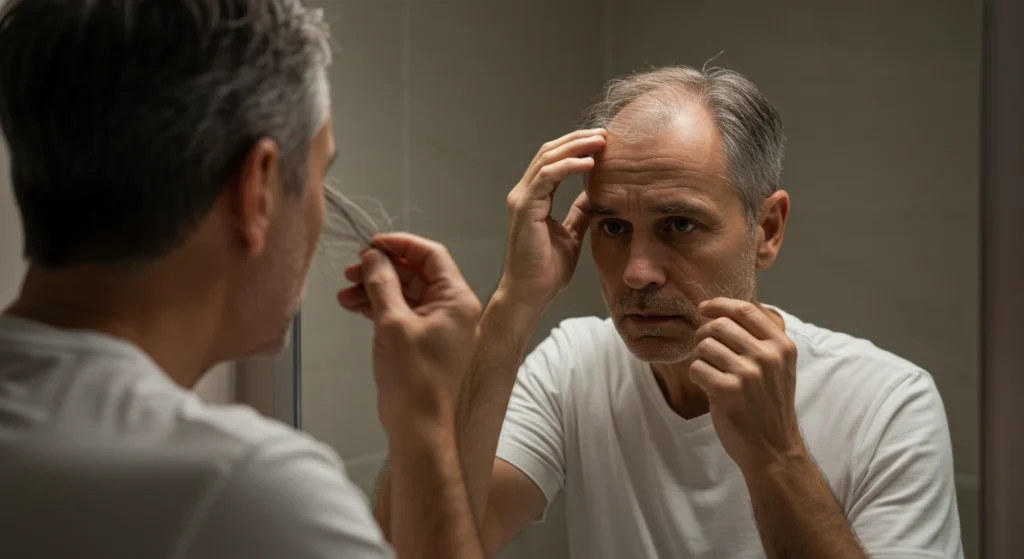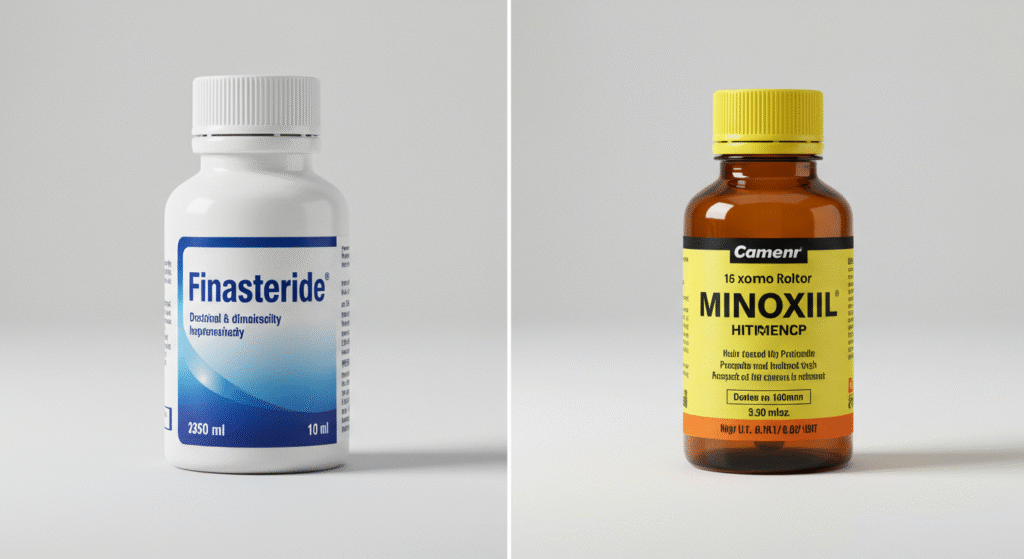Worried about What Age Does Hair Loss Start? Hair loss age varies widely, but it often starts earlier than people realize. This article breaks down when hair loss typically begins, why it happens, and how you can manage or prevent it.
You’ll learn about signs to watch for, treatments that actually work, and expert-backed advice for every stage of life. Whether you’re in your teens or your 50s, this guide helps you take control with clarity and confidence.
[Medical Reviewer Note Needed Here]
At What Age Does Hair Loss Typically Start?

Hair loss doesn’t wait for old age—it can begin much earlier, depending on genetics, hormones, and health.
Common Age Ranges for Hair Loss in Men
- Most men start noticing some form of hair thinning by their late 20s to early 30s.
- Male pattern baldness (androgenetic alopecia) can begin as early as age 18–20.
Common Age Ranges for Hair Loss in Women
- Hair loss in women is usually more gradual and starts post-30s, becoming noticeable in the 40s–50s.
- Hormonal changes (e.g., pregnancy, menopause) often trigger or worsen hair thinning.
- Female pattern hair loss often presents as diffuse thinning, not bald spots.
Is Teenage Hair Loss Normal?
While rare, teens can experience hair loss due to:
- Extreme stress (e.g., exams, emotional trauma)
- Crash dieting or eating disorders
Early Signs of Hair Loss to Watch For
Detecting early hair loss helps with faster intervention. Look out for:
- Receding Hairline (especially at the temples)
- Thinning at the Crown — a classic male-pattern sign
- Widening Part in Women may signal diffuse thinning
- More Hair in Shower or Brush — consistent shedding beyond 100 hairs/day
Pro Tip: Take monthly photos under the same lighting to track changes in density.
Common Causes of Hair Loss at Different Ages
Genetic and Hormonal Causes
Understanding “why” is key to treatment.
- Hereditary hair loss (androgenetic alopecia) is the most common.
- Hormonal imbalances like DHT sensitivity affect hair follicles.
Stress, Illness, and Medication

- Telogen effluvium (temporary shedding) can follow fever, surgery, or emotional shock.
- Some medications, including antidepressants and blood thinners, list hair loss as a side effect.
Poor Nutrition and Lifestyle Factors
- Deficiencies in iron, zinc, or protein impact hair health.
- Smoking, poor sleep, and excessive alcohol consumption accelerate aging, including your scalp.
Menopause or Andropause
- Estrogen and testosterone shifts disrupt hair cycles.
- Hair may become finer, slower-growing, or start falling out.
Hair Loss by Decade: What to Expect
In Your 20s
- Early signs may show at the temples or the crown.
- Often dismissed as “just stress,” a missed treatment window.
In Your 30s
- Thinning becomes more visible.
- Ideal age for non-surgical treatments like PRP or minoxidil.
In Your 40s and Beyond
- Volume loss accelerates.
- Scalp visibility increases, especially in women post-menopause.
- May require combination treatments, including hair transplants.
Can Hair Loss Be Prevented or Slowed Down?
Yes, especially when treated early.
Early Intervention Options
- Topical minoxidil (FDA-approved)
- Finasteride for men (consult a doctor first)
- PRP therapy for both genders

Lifestyle Changes That Help
- A balanced diet rich in iron, zinc, and biotin
- Stress management techniques (meditation, sleep hygiene)
- Scalp massage to stimulate circulation
When to See a Doctor or Trichologist
- If shedding exceeds 100 hairs daily for more than 2–3 weeks
- Sudden or patchy loss (could signal alopecia areata or thyroid issues)
Treatment Options Based on Age
Teenagers and Young Adults
- Focus on nutritional support, stress control, and early diagnosis.
- Avoid aggressive treatments; monitor with a specialist.
Adults in Their 30s and 40s
- Ideal candidates for topical/oral medication, PRP, and microneedling.
- Hair transplant becomes viable for stable pattern baldness.
Older Adults and Seniors
- Combine cosmetic concealment (fibers, wigs) with mild therapy.
- Ensure no underlying health issues like anemia or thyroid disorders.
Non-Surgical vs Surgical Treatments
- Non-surgical: Minoxidil, finasteride, PRP

Expert Tips for Managing Hair Loss at Any Age
- “Consistency is key — treatments don’t work overnight.” — Dr. Rana Irfan, ABHRS-certified Hair Transplant Surgeon
- Use gentle, sulfate-free shampoos and avoid excessive heat styling.
- Regular scalp checks every 6–12 months for pattern monitoring.
- Join support communities or hair loss forums to stay informed.
Frequently Asked Questions (FAQs)
Does hair loss mean I’m aging too fast?
Not necessarily. Genetics and hormones often play a bigger role than actual aging.
Is hair loss at 18 or 20 normal?
It can happen, especially if there’s a strong family history. Early diagnosis is crucial.
Will hair loss always get worse with age?
Not always. With proper care and treatment, it can be slowed or stabilized.
Can early treatment reverse genetic hair loss?
Reversal is rare, but early treatment can significantly slow down or even halt progression.
Don’t Wait for It to Get Worse
Worried about early hair loss? Book a consultation with Dr. Rana Irfan in Islamabad today—an ABHRS-certified expert in advanced hair restoration. Early intervention leads to better outcomes, so take the first step now.
